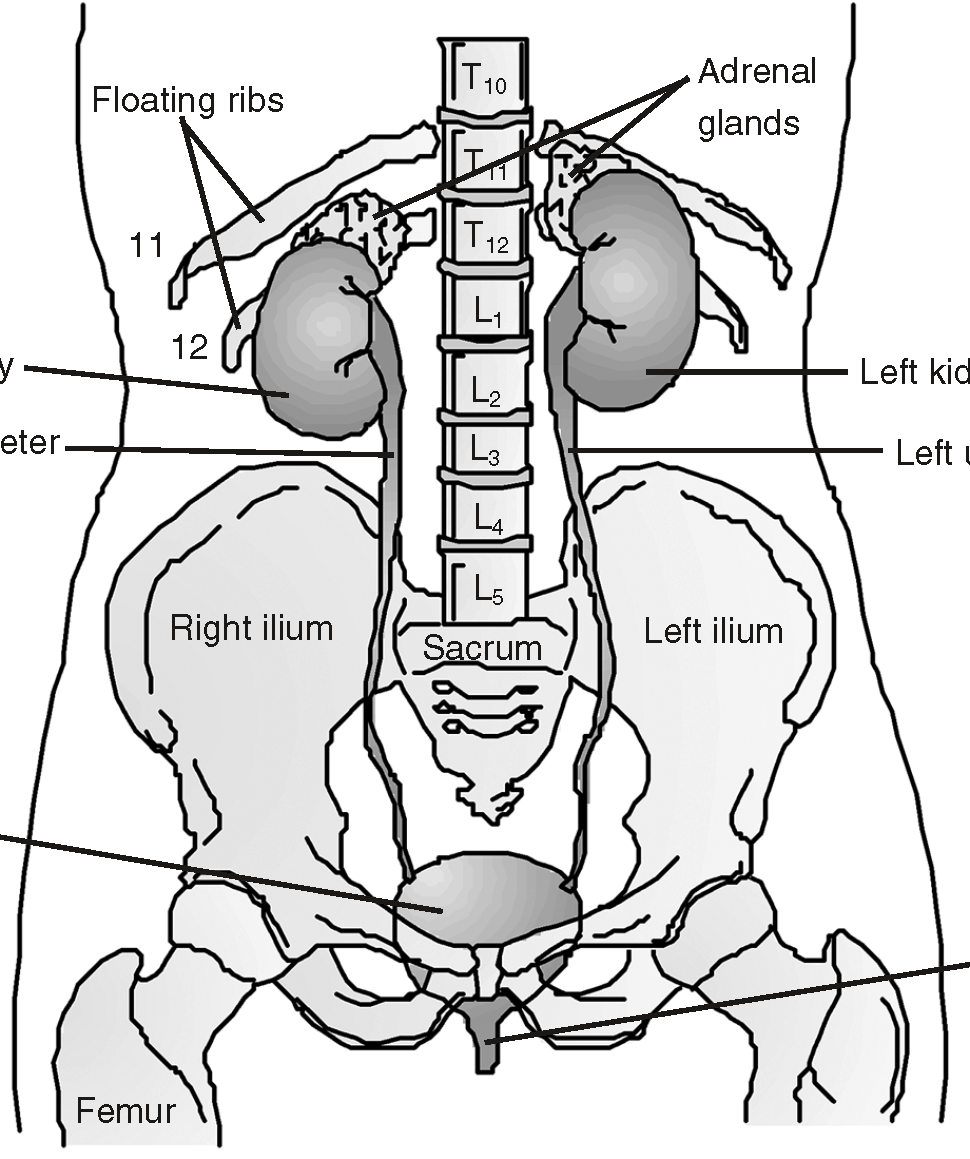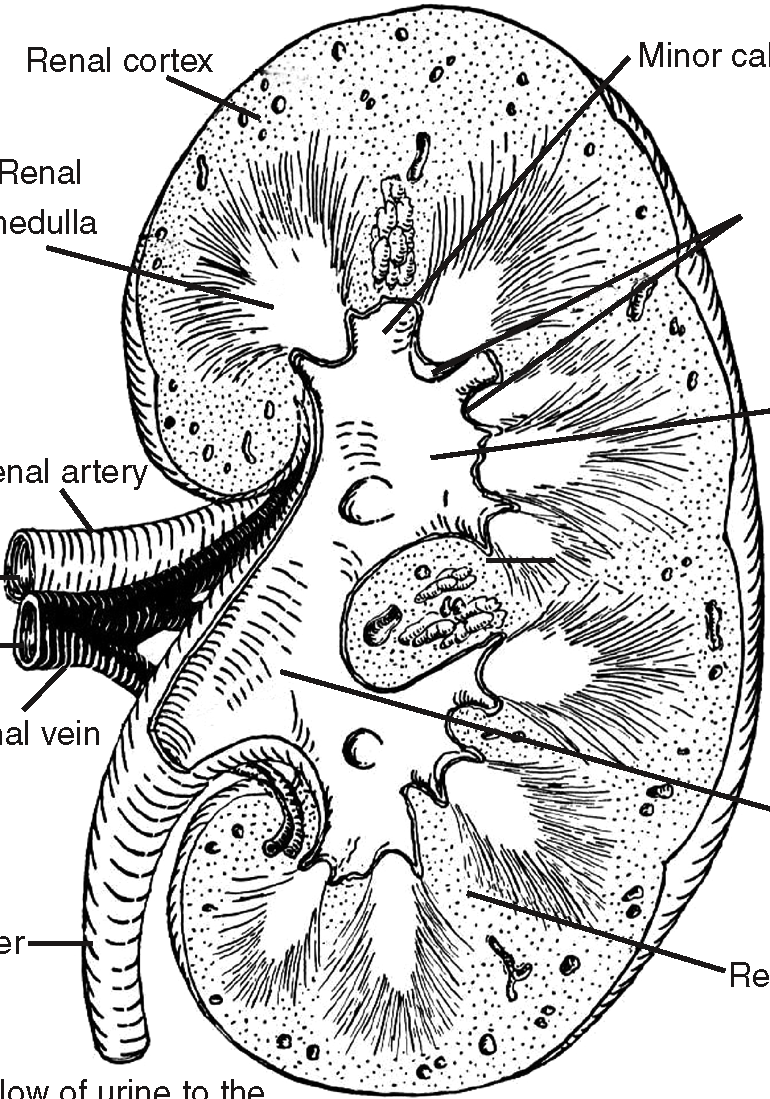Anatomy and Physiology: Waterworks
Waterworks
As I mentioned in Cardiovascular and Lymphatic Circulation, the kidneys like to stay in the background, so much so that they are actually hidden behind the abdominal wall! Figure 15.1 shows the left kidney a little higher than the right kidney, which makes sense with that honkin' big liver in the way! Their familiar shape is like a large, uh, kidney bean that has been punched in on one side. That punched-in portion, like that of the lung, is called the hilus, and it is the location for the renal artery and renal vein, as well as the ureters. Ureters carry the waste-filled urine made by the kidneys down to the next stop, the urinary bladder.
Medical Records
Since not all of our evolutionary ancestors were concerned with decency in terms of urination, why bother storing the urine in the first place? There are two reasons why this trick, for which we can thank the bladder, evolved. The first reason makes a lot of sense right away; these are wastes, after all, so do you really want them in your den? Wouldn't it be healthier to be able to leave it farther away? The second reason makes sense if you have ever had a male dog; dogs don't just pee, they mark their territory! To do that, you need to be able to pee on command. I just wish with my dog Milo that he would pee on my command, and not his!
More primitive organisms simply release wastes constantly, but we have a urinary bladder to store it until there is a socially acceptable opportunity to get rid of it, through the urethra, that little tube from the bladder to the outside world.

Figure 15.1The organs of the excretory (urinary) system dump the blood's wastes into the outside world. (LifeART©1989-2001, Lippincott Williams & Wilkins)
Not Just a Bean …
The kidneys don't quite look how most people expect them to look, having seen so many clean-looking diagrams (such as Figure 15.1). This is because diagrams usually show only the innermost of the three outer layers, the renal capsule. This layer is smooth, fibrous, and even transparent, and it prevents infections from reaching the kidney; this layer is also contiguous with the hilus.
The next two layers are more important in terms of protection from trauma. The kidneys, after all, are very close to the dorsal surface of the body, and they can be easily damaged, which is why the -kidney punch is illegal in boxing. The middle, fatty layer is, and rightly so, called the adipose capsule, and the outermost layer of dense irregular connective tissue is called the renal fascia. In addition to protec tion, together these two layers anchor the kidney in place.
Medical Records
One danger of being too thin—you know, the media driven craze to look like a stick insect—is nephroptosis, or floating kidney. If the adipose capsule is too thin the kidney may drop out of place, making a kink in the ureter, blocking the flow of urine. In addition to pain, this can also damage the kidney—whoever said all fat is bad?
The inside of the kidney looks a little like the inside of a lymph node, complete with the pyramid-shaped structures, this time called renal pyramids. In between the pyramids are columns of tissue called, of course, renal columns. Also similar to the lymph nodes is an outer cortex (the renal cortex), followed by an inner medulla (the renal medulla).
The inside of the kidney is where the filtering of wastes happens, but where do wastes go after that? Think about the pipes in your home. You probably have two or more sinks, at least one toilet, and one bathtub. Where does all that water, and everything else go? Smaller pipes merge with larger pipes, until the largest pipe makes its odoriferous way to the sewer or septic tank. The kidney works the same way! The collecting system starts with small collecting ducts that empty the urine into a larger duct, which empties into a minor calyx, which empties into a major calyx, which empties into the renal pelvis, which finally dumps its contents into the ureter (see Figure 15.2).
Flex Your Muscles
Don't fall into the trap of thinking that the cortex is the core. You should, however, think of the medulla as the middle, for that's what it is!

Figure 15.2The anatomy of that urine-spitting machine, the kidney. (© 2003 www.clipart.com)
I Need to Get Out!
The rest of the trip is rather uneventful. After collecting in the renal pelvis, the urine makes a long trip down the ureters, which are hiding behind the posterior peritoneum, or posterior abdominal wall (refer to Figure 15.1). The two ureters attach separately to opposite sides of the dorsal surface of the urinary bladder. Females, on average, have a smaller bladder capacity than do males due to the position of the uterus curving directly behind and above the bladder.
Medical Records
Keep that in mind the next time a pregnant woman is behind you in line for the bathroom! Now imagine that the uterus is occupied. During pregnancy, the size and weight of the uterus increase—don't forget to add the weight of the amniotic fluid, too! Some of that mass will extend forward, causing a pregnant woman to rearrange her footing to account for the different center of gravity, and some will be supported by the flared ilia of the female pelvis (see The Joints), but the rest of the mass compresses the urinary bladder.
From the bladder it's a short trip outside through the urethra. Men have a longer urethra, due to its position running down the length of the penis. One of the implications of this is the greater frequency of bladder infections in women than in men. As to the exit from the urethra, it is similar to the anus (see The Excretory System) in that there are two sphincters: the involuntary internal urethral sphincter (which relaxes when you have to pee), and the voluntary external urethral sphincter (which relaxes when you do pee). Once again, babies have yet to develop voluntary control over that external sphincter. If you have a child, chances are you've been peed on!

Excerpted from The Complete Idiot's Guide to Anatomy and Physiology © 2004 by Michael J. Vieira Lazaroff. All rights reserved including the right of reproduction in whole or in part in any form. Used by arrangement with Alpha Books, a member of Penguin Group (USA) Inc.
To order this book direct from the publisher, visit the Penguin USA website or call 1-800-253-6476. You can also purchase this book at Amazon.com and Barnes & Noble.







